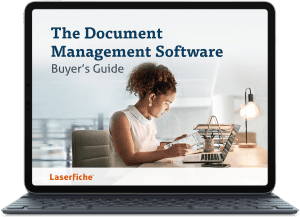Most document management systems can be considered records management systems, but not all. Thus, a robust DMS can set up your organisation for success. Read on to see why knowing the difference between the core concepts of document and records management can help you make the right choice when choosing software for your organisation.
Below are definitions of each term, followed by the three key characteristics that distinguish these practices from one another.
What is document management system?
A document management system involves the capture, storage, modification and sharing of physical files within an organisation.
Generally speaking, practicing document management offers opportunities to:
- Reduce lost and misfiled documents.
- Provide faster search and retrieval of documents.
- Help better organise existing documents.
- Improve business processes and organizational efficiency.
- Reduce the amount of physical space used to store documents, such as file cabinets, boxes and shelving.
What is a records management system?
Records management systems establish policies and standards for maintaining diverse types of records. Some, but not all, documents within an organisation become records.
Records management can be thought of as a subset of document management that can also bolster efforts to:
- Distinguish non-record content from records.
- Apply required retention periods to records.
- Identify the owners of records.
- Determine that a chain of custody and a proper audit trail both exist for each record.
- Assist in e-discovery issues and applying legal holds to records when needed.
- Manage the proper and timely disposition of records.
- Develop and administer records policy and procedures for electronic or paper records.
- Preserve records throughout their life cycle.
What makes document and records management systems different?
Although you may use the same system for document management and records management, these types of content are managed differently. These differences in management practices include: the goal, or purpose of each practice, the information or content involved in each practice, methodology, or the way each practice is performed.
Goal
The goal of document management is efficiency. Approving documents faster, reducing manual data entry and automating recurring tasks are some of the many functions of document management that work toward this goal.
The goal of records management is compliance. A well-maintained records management system helps organisations avoid penalties when audited by regulators, auditors and other governing bodies.
Document management and records management share a common goal of business continuity. Shortcomings in either can contribute to organisation-wide challenges. However, when both document and records management work toward their goals (efficiency and compliance), organisation resiliency is better within your reach.
Information
The information of document management is comprised of transient content. Invoices are signed and then sent off to the next approver, older drafts are discarded for revised ones, forms pass from submitter to reviewer and so on.
The information of records management is comprised of historical content. The status of a document is determined by different phases of the records lifecycle, as shown below:

Methodology
The methodology of document management is content-driven. As mentioned above, content is the catalyst for all document-related activity. Therefore, document repositories are usually organised with the needs of general users in mind: finding documents by keyword or title, keeping all documents together by employee or project, etc.
In contrast, the methodology of records management is context-driven. Records managers care more about document types (insurance records, employment applications, etc.) than the words written on the actual documents. As a result, retention schedules are the catalyst for records-related activity, as different types of records must be kept for different lengths of time, and under different conditions.
For an overview of how document management can help your organisation streamline operations, watch the Laserfiche webinar, ECM 101: An Introduction to Document Management Features.
eBook: The Document Management Software Buyer’s Guide
Learn what document management is, why organizations need it and how to procure the right software for your workplace.
Get your eBook



